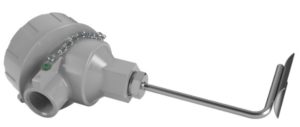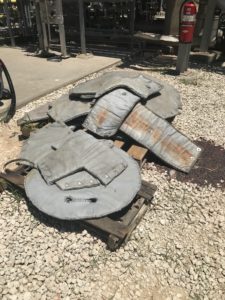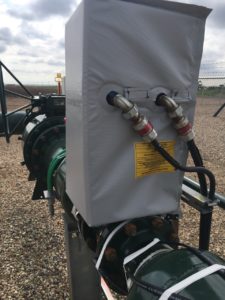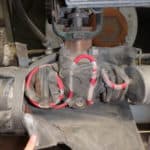Line Sensing vs Ambient Sensing
The location where a sensor is placed is critical in the function of a good heat trace system. Contractors or installers seldom own the facility where they install a system. If they did own it, they might stop and think a little more often about where the actual best place to install a sensor would be when they built the heat trace system, wouldn’t they?
The best place to have a sensor is always where temperature is most critical. Heat trace circuits can be anywhere from ten feet to hundreds of feet long. But where along any given run is the most important place for the content of that pipe to be at temperature? First, let’s define two important terms: line sensing and ambient sensing.
What is line sensing?
Line sensing is when temperature sensors are located on the surface of the product being controlled.
What is ambient sensing?
Ambient sensing is when temperature sensors measure air temperature and decide what outside air temperature would be appropriate to turn a heat trace system on to protect that process.
Both ambient sensing and line sensing have their advantages and disadvantages. Let’s take a deeper look to see which type of temperature measurement sensor system would work best for your application.
Ambient sensing
Ambient sensing applications tend to be freeze protection applications. Having a sensor outside that can tell when temperatures are close to freezing signals the heat trace system to apply power to the individual circuits to begin heating, preventing the contents of that pipe or vessel from freezing. Normally there is just one sensor for the entire system. You could have one sensor telling dozens of circuits to come on all at once. These are very simple control systems, and can be very effective if installed properly.
Problems with ambient sensing
So what could go wrong with ambient controlled systems? Here are few things to consider:
- Having just one sensor does not give you good insurance. If the sensor fails, you have no temperature measurement to make a decision with. Investing in a secondary or back up sensor for your system is a wise precaution.
- The location of the sensor is a very common issue when troubleshooting a heat trace system with ambient sensing. Some of the more simple systems include a very old fashioned thermostat with a mercury filled bulb and capillary that is attached right to the thermostat. If that thermostat and sensor are placed somewhere that cannot feel cold ambient temperature, it may be too late for the system to engage. These sensors are often at “Man Level” as well, where things get kicked, knocked off or otherwise damaged. Putting a sensor high up in the air and away from possible mechanical damage (usually on the north side of the facility) is a smart improvement for ambient temperature systems. This often requires slight changes in the controller and sensor, for which a NPT LB mounted style RTD is a great option. The RTD can be mounted in a standard ½” FNPT(Insert pic of the PT RTD) LB fitting to conduit, then the 3 conductor RTD wire can be run back to the controller. This controller can then actuate the control panel as originally designed.
What is line sensing?
Line sensing heat trace systems have the sensor placed on the surface of the system needing to be maintained. It is common for multiple pipes or vessels on the same heat trace control system to have many circuits with each individual line having its own different required control temperature.
Just as with ambient temperature sensing systems, where line sensors are placed is vital in the performance of the system. Engineering drawings will often have the sensors placed randomly with no consideration of that sensor location. Contractors often place sensors where it’s convenient to locate them (for example, in close proximity to a power drop). While it’s convenient to run conduit and power wires and “drop” to equipment requiring that power, locating a sensor at that same location is not always the most optimal location for a process
Line sensing in piping
For piping, attaching the sensor to the pipe mechanically is key to long term reliability. An RTD like this  attaches to the pipe surface with a pipe clamp, and then is insulated over.
attaches to the pipe surface with a pipe clamp, and then is insulated over. Many clients prefer to measure the temperature at the end of a piping run so that it is at the proper temperature once it reaches its destination. There are systems available that can measure temperature at multiple locations along a run if this is required. Placing multiple RTD’s or Thermocouples along that pipe run, as well as having a controller that can monitor temperature, manage data and make a decision for heat output, would also be needed.
Line sensing in vessels
For vessels, consider if it is a horizontal or vertical tank. Heat rises, so it is common to have more electric heat trace on the bottom runs than on the top. Stacking your sensors perpendicular to the ground so that the zones can turn on and off as the heat rises would be much more effective. Make sure that the sensor is touching the surface of the tank. Banding clamps are often used to fix the sensor in place, and in some cases mechanical attachments are also used. You want to be touching the surface of that vessel since you are depending on it to transfer the heat to the product in the tank.
Line sensing in valves and pumps
It’s also important to consider critical pumps and valves in a line sensing application. If you have a valve or pump that is going to require more service than anything else on that individual heat trace circuit, think about making some modifications.
- If you are using removable insulation blankets for that pump or valve, what about having a separate heat trace circuit for just that unit? That way, the rest of the heat trace for that pipe run is not dependent on how well someone replaces that jacket or heat trace once maintenance is done. It’s very common for a valve or pump to be worked on or replaced, and then the heat trace or insulation jacket does not get put back on correctly. Making a separate circuit just for that critical part could be the answer.

- Consider using a Powerblanket heated jacket for that valve or pump. With up to 10x as much heat capability vs heat trace over the same surface area, more effective heat can be useful. Being able to remove an insulation jacket with integrated heat inside the blanket all in one shot can also be a big plus. With Powerblanket, there’s no wrangling heat trace cable and trying to put it back on just right.

Is line sensing better than ambient sensing?
There is a strong argument that all applications should be line sensing. Think about a freeze protection system for piping as an example. If it is 35F outside, and the pipe under the insulation is still at 45F, you have 12 degrees to go before it freezes. Line sensing is much more effective and probably a better use of electricity as well. This type of system requires a more complex control system, but the savings in electricity over time on a large system would quickly pay for itself. Turning things on at 45F isn’t a bad idea if you live in a consistently cold climate.
Call the line sensing experts at Powerblanket today and let’s visit your system. We would be glad to help in any way to create a custom heat plan and get your freeze protection system operating efficiently.
Frequently Asked Questions
What is ambient sensing?
Ambient sensing involves using sensors to measure environmental parameters like temperature, motion, light, and humidity to monitor and respond to changes in the surroundings, often used in freeze protection applications.
What does an ambient sensor do?
An ambient sensor measures environmental conditions, such as air temperature, to provide data that can trigger systems like HVAC or heat trace systems to maintain optimal conditions.
What is an example of ambient technology?
Examples of ambient technology include smart home devices like voice assistants and IoT-enabled sensors that monitor environmental conditions to automate responses.
What is the difference between line sensing and ambient sensing?
Line sensing involves placing sensors directly on the surface of the item being monitored for precise temperature control, while ambient sensing measures the surrounding air temperature to activate systems like heat trace for freeze protection.
Don't let the cold weather stop your business. Powertrace heat trace cable will keep you running smoothly no matter how low the temperatures.



